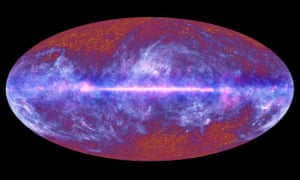That this can give us an architecture for mass distribution is helpful and to see it also confirmed is also good. Otherwise i am hesitant to assign the missing mass problem to it at all.
These filaments may well carry scant mass at all and that is the reason that they even exist intact through billions of years.
Good stuff though.
.
Scientists produce indirect evidence of gaseous filaments and sheets known as Whims linking clusters of galaxies in the cosmic web
The warm-hot inter galactic medium, or the Whim ought to appear as a dim outline in the cosmic microwave background, scientists say. Above, a map of relic radiation from the big bang, composed of data gathered by the Planck satellite. Photograph: HO/AFP/Getty Images
Hannah Devlin
@hannahdev
https://www.theguardian.com/science/2017/oct/12/astronomers-find-half-of-the-missing-matter-in-the-universe?CMP=share_btn_fb
Thursday 12 October 2017 15.38 BST Last modified on Thursday 12 October 2017 18.18 BST
It is one of cosmology’s more perplexing problems: that up to 90% of the ordinary matter in the universe appears to have gone missing.
Now astronomers have detected about half of this missing content for the first time, in a discovery that could resolve a long-standing paradox.
The conundrum first arose from measurements of radiation left over from the Big Bang, which allowed scientists to calculate how much matter there is in the universe and what form it takes. This showed that about 5% of the mass in the universe comes in the form of ordinary matter, with the rest being accounted for by dark matter and dark energy.
Dark matter has never been directly observed and the nature of dark energy is almost completely mysterious, but even tracking down the 5% of ordinary stuff has proved more complicated than expected. When scientists have counted up all the observable objects in the sky – stars, planets, galaxies and so on – this only seems to account for between a 10th and a fifth of what ought to be out there.
The deficit is known as the “missing baryon problem”, baryons being ordinary subatomic particles like protons and neutrons.
Richard Ellis, a professor of astrophysics at the University College London, said: “People agree that there’s a lot missing, raising the question where is it?”
The distribution of galaxies in the universe follows a web-like pattern and scientists have speculated that the missing baryons could be floating in diffuse gaseous filaments and sheets linking the galaxy clusters in the cosmic web.
Theoretical calculations suggest these gaseous threads, known as the warm–hot intergalactic medium, or the Whim, ought to be around a million degrees celsius. A mist of gas at this temperature is too cold to emit X-rays that could be spotted by ordinary telescopes from the Earth – but not cold enough to absorb significant amounts of light passing through it.
“The trouble is, it’s in this unusual temperature regime where we can’t see it,” said Ellis.
Now two separate teams of scientists, one at the University of Edinburgh, the other at the Institute of Space Astrophysics in Orsay, France, have produced compelling indirect evidence for the Whim. Both teams relied on the fact that when radiation travels through a hot gas, it is scattered, meaning that the Whim ought to appear as a dim outline in the cosmic microwave background.
The scientists overlaid observations of the cosmic background radiation, made by the Planck space observatory, and the most detailed three dimensional map of the cosmic web, created by the Sloane Digital Sky Survey (SDSS). They hypothesised that if there were gas threads linking galaxy clusters, these should show up in the Planck data.
The Edinburgh team found the regions between galaxies appeared to be about six times as dense as the surrounding bits of space and when summed up, these gaseous threads could amount to about 30% of the ordinary matter in the universe. The French teams’ calculation came out at slightly less than this, but the numbers are consistent.
Ellis, who was not involved in either project, describes the findings as “inspirational”. “These two papers have been very prominently discussed and people are excited,” he added. “The Whim is out there.”
The initial measurements still do not account for all the ordinary matter, and some believe the remaining portion could be made up by exotic unobserved objects such as black holes or dark stars. Cosmologists are also still yet to discover the nature of dark matter, which makes up even more of the universe.

No comments:
Post a Comment